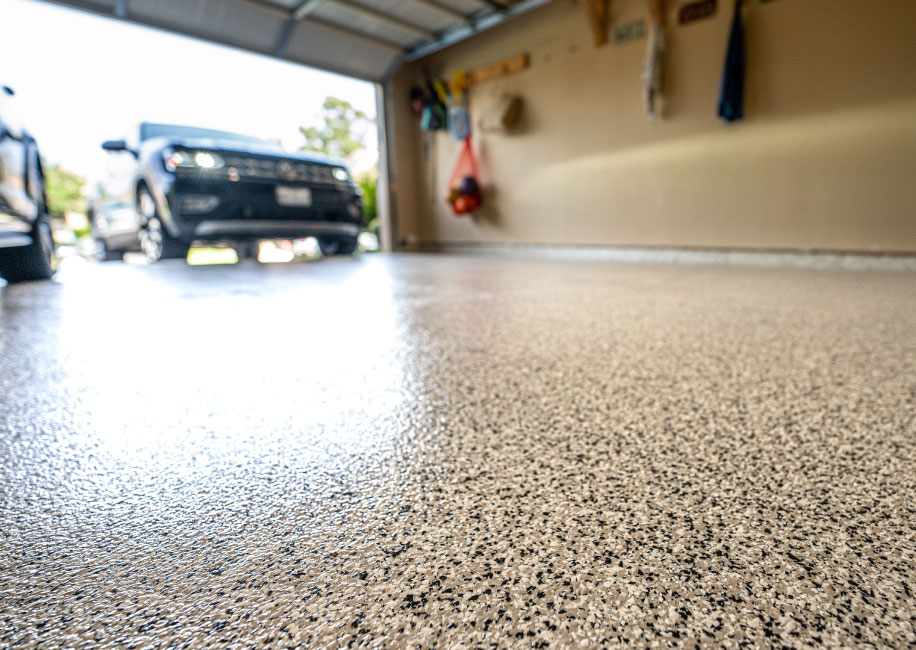Is Epoxy Flooring Right for Your Colorado Garage?
The Pros and Cons of an Epoxy Garage Floor
Your garage floor takes a beating. Between vehicle traffic, oil drips, seasonal temperature swings, and whatever projects you’re working on, that concrete slab endures more daily abuse than almost any other surface in your home. For most homeowners, the question isn’t whether to upgrade, it’s which option actually delivers long-term value.
Epoxy flooring continues to grow in popularity for good reason; it creates a durable surface that handles heavy use while looking significantly better than bare concrete. With proper installation and care, these floors can last well over 20 years. According to real estate experts, professional epoxy installation can even boost your property’s value by 5-10%.
However, Colorado’s unpredictable climate creates unique challenges you won’t face in other parts of the country. Temperature swings, intense UV exposure, road salt, and several other factors all impact how epoxy performs over time. Research shows that 73% of epoxy floor coatings can crack or peel within two years when subjected to extreme temperature fluctuations without proper installation techniques.
Let’s cut through the hype and get the real story on whether epoxy is right for your garage floor.
What Makes Epoxy Garage Floors So Popular
Business owners and homeowners keep asking us the same question: why is everyone choosing epoxy?
Four key advantages explain why epoxy has such a positive impact on garage owners and business managers.
Exceptional Durability
Durability stands as epoxy’s biggest selling point. Industrial-grade epoxy creates a bond that’s ten times stronger than steel, giving you a surface that handles everything from snowmobiles to motorcycles with ease. These floors can reach flexural strength of 10,000 psi—strong enough to withstand heavy machinery, constant vehicle traffic, and the gear loading that comes with serious outdoor adventures.
In real-world terms, here’s what that means:
- Professionally installed epoxy floors last 10-20 years with basic care
- The surface resists impacts, scratches, and abrasions that destroy standard concrete
- Chemical resistance protects against oils, gasoline, and the automotive fluids that inevitably end up on garage floors
Epoxy’s chemical resistance becomes essential during the winter months. Road salt, de-icing chemicals, and the constant wet-dry cycles that come with our climate can devastate unprotected concrete. While epoxy isn’t invincible against salt damage (we’ll address that limitation later), it provides significantly better protection than bare concrete.
Low Maintenance That Actually Saves Time
After spending your weekend adventuring and keeping up with life, the last thing you want is hours of garage maintenance. Epoxy floors require minimal upkeep—a regular sweep and occasional mop keep them looking showroom-quality.
The non-porous surface means spills don’t stain. Oil drips from your truck? Wipe those up in seconds instead of leaving a permanent mark. Automotive cleanup becomes simple, which matters when you’re constantly tracking in mud, sand, and snowmelt from your adventures.
Epoxy also resists moisture naturally, preventing the mold and mildew growth that plagues many Colorado garages. Given our state’s wild humidity swings—from bone-dry winter air to summer thunderstorm moisture—this protection provides real value.
Customization Options to Match Your Style
Your garage shouldn’t just be functional—it should reflect your personality. Modern epoxy systems offer dozens of color and pattern combinations to match your home’s aesthetic or make a bold statement. Popular design options include:
- Metallic finishes that create marble-like effects or flowing water patterns
- Decorative flake systems in custom color blends (though be aware: multi-colored flakes can make dropped screws and washers nearly impossible to find)
- Custom borders and patterns that add visual interest to large spaces
- Logo integration for car enthusiasts who want showroom vibes
Enhanced Safety and Lighting
Epoxy’s reflective surface can make your garage significantly brighter, reducing the need for additional lighting while creating a safer workspace.
You can also add anti-slip additives to the epoxy coating for better traction during wet conditions. This matters during snowy months when you’re tracking moisture inside. The smooth, seamless installation eliminates trip hazards you’d find with other flooring options, creating a safer environment whether you’re loading ski equipment or working on your bike.
Challenges and Limitations
While epoxy flooring offers significant advantages, it’s not a perfect fit for every garage owner.
Complex Installation That Demands Expertise
Epoxy installation isn’t a weekend DIY project if you want results that last. The DIY route typically takes several days and requires meticulous attention to detail at every step.
Surface preparation makes or breaks your floor. The concrete needs diamond grinding or shot blasting to create the proper surface profile. Acid washing alone won’t cut it—you need mechanical preparation to achieve proper adhesion. All cracks must be repaired, and the surface needs deep cleaning and degreasing to remove any contamination that could prevent bonding.
Environmental control during installation. Humidity levels must stay below 85% (ideally 50-60%) throughout the process. Research shows that relative humidity above 85% increases amine blush formation by 300%, leading to cloudy, improperly cured coatings.
Temperature matters just as much. Epoxy needs to be applied between 60°F-85°F for optimal results. Colorado’s temperature swings make this tricky—too cold and the epoxy thickens, leading to poor adhesion and patchy appearance. Too hot and it cures too quickly, trapping air bubbles and creating texture problems.
Small mistakes have big consequences. Studies show that professional installation reduces temperature-related curing defects by 68% compared to DIY applications. Professional contractors use industrial-grade equipment and higher-quality materials with bigger temperature windows than what you’ll find in big-box store kits.
Climate: Epoxy’s Biggest Challenge
Epoxy faces serious challenges in Colorado’s unpredictable conditions that need to be taken into consideration.
Temperature Fluctuation:
Research reveals a concerning statistic: 73% of epoxy floor coatings can crack or peel within two years when subjected to extreme temperature fluctuations. Colorado delivers exactly these conditions—summer garage temperatures can hit 140°F while winter nights drop below zero.
The problem comes from thermal expansion. Concrete naturally expands and contracts with temperature changes. Epoxy’s rigid nature makes it susceptible to cracking as the concrete underneath moves. Specialized epoxy blends can withstand over 5,000 thermal cycles, but regular epoxy coatings can lose up to 40% of their strength from repeated expansion and contraction.
You’ll also encounter the “hot tire pickup” phenomenon. On scorching summer days, vehicle tires heat up enough to soften the epoxy coating. When you park, the softened epoxy can adhere to your tires and delaminate from the floor—leaving visible damage that’s difficult and expensive to repair.
UV Degradation in Colorado’s Intense Sunlight:
Surprisingly, standard epoxy is not UV stable. Colorado’s intense sunshine can cause epoxy to yellow, fade, or chalk over time. UV radiation breaks down the chemical bonds in epoxy, causing both discoloration and surface degradation.
This particularly affects garages with windows or those that connect to outdoor spaces. While UV stabilizers added during installation can reduce this issue, they don’t eliminate it. If UV resistance is critical for your situation, polyaspartic coatings offer superior performance in this area—they’re UV-stable and won’t yellow or fade over time.
Road Salt and Moisture Concerns:
Winter in Colorado means road salt and de-icing chemicals are constantly tracked into your garage. While epoxy provides significantly better protection than bare concrete, it’s not invulnerable to salt damage.
Salt creates several problems:
- Surface abrasion from salt particles can scratch and dull the finish over time
- Moisture attraction can lead to water penetration, particularly if micro-cracks develop
- Staining potential from salt impurities, especially calcium chloride
Regular cleanup of salt accumulation helps prevent long-term damage, but you need to understand that constant salt exposure will impact your floor’s appearance over time.
Repair Challenges That Require Professional Help
Unlike other flooring options, where you can patch damaged areas independently, epoxy repairs typically require working on the entire surface to maintain a uniform appearance. Even small issues like bubbling, peeling, or discoloration usually need complete refinishing rather than spot repairs.
DIY repair attempts rarely blend well with existing coatings, creating obvious patches that look worse than the original damage. For serious issues, you’ll need a professional assessment to determine whether spot repair or complete replacement makes financial sense.
This differs significantly from polished concrete, which can be re-polished when damaged. With epoxy, you’re committed to professional maintenance or full replacement when problems develop.
Slippery When Wet
This is the most frequent customer complaint we hear: epoxy floors become extremely slick and cause slipping when wet. The smooth, glossy finish that creates that attractive showroom look also creates a genuine safety hazard in the presence of water, oil, or other fluids.
This matters in Colorado garages where you’re constantly tracking in snow, ice, and moisture during the winter months. The problem can be mitigated with anti-slip additives mixed into the topcoat, but this comes at additional cost and slightly reduces the high-gloss appearance many owners appreciate.
Making the Right Choice for Your Colorado Garage
Your garage should be ready for whatever adventure comes next—whether that’s loading up for a weekend in the backcountry or wrenching on your truck after it gets you through a gnarly trail.
Epoxy flooring delivers exceptional value when:
- Your garage stays relatively temperature-stable
- You have minimal direct sunlight exposure
- You’re willing to maintain regular cleaning, especially after winter
- Professional installation is part of your budget
- You want customizable aesthetics at a reasonable price point
Consider polyaspartic instead when:
- Your garage experiences extreme temperature swings
- Large windows or southern exposure create significant UV exposure
- Fast cure time matters (need your garage back quickly)
- Maximum chemical and salt resistance is priority
- Budget allows for premium investment
Stick with sealed concrete if:
- Your garage is actively used for messy projects
- Budget is tight and DIY isn’t feasible
- You’re comfortable with industrial appearance
- Temperature control during installation isn’t possible
At Horizons Epoxy, we don’t believe in one-size-fits-all solutions. Our team evaluates your specific garage conditions, usage patterns, and budget to recommend the flooring system that actually makes sense for your situation—not just what we want to sell.
Ready to Transform Your Garage?
Your garage deserves the same attention as the rest of your home—maybe even more, given the daily abuse it takes from Colorado’s weather and your outdoor lifestyle.
During your consultation, we’ll discuss:
- Your garage’s specific challenges and conditions
- Epoxy vs. polyaspartic recommendations for your situation
- Custom design options that match your style
- Realistic timeline and cost expectations
- Warranty and maintenance requirements
Whether you choose epoxy, polyaspartic, or another solution, you’ll get honest guidance from professionals who’ve installed hundreds of Colorado garage floors. We’re not here to sell you the most expensive option—we’re here to create a floor that performs reliably for decades while looking incredible.
Let’s turn that cracked, stained concrete into an adventure-ready space that makes you smile every time you pull in from the mountains.


